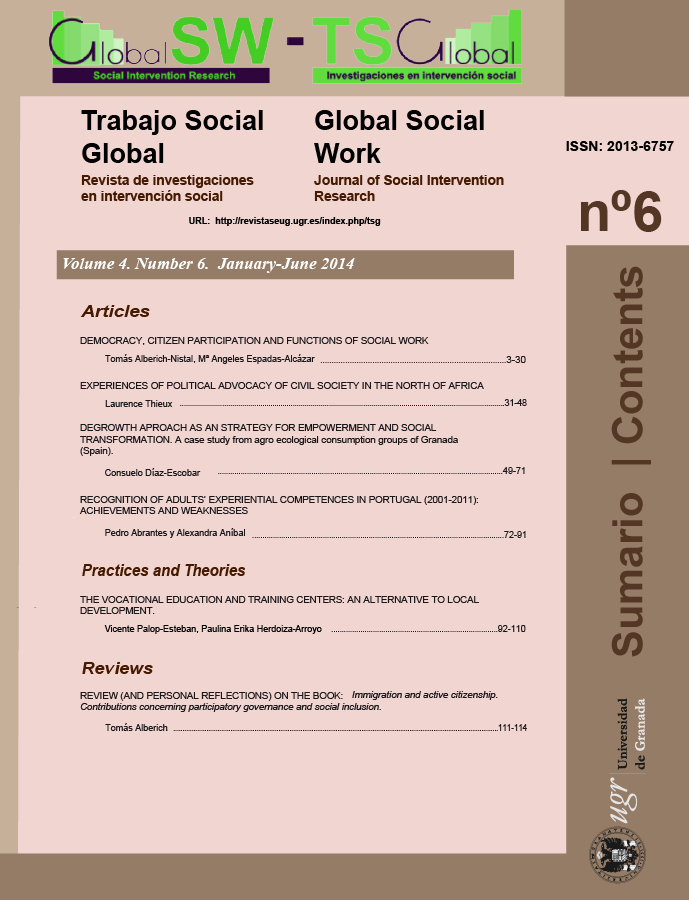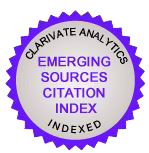THE VOCATIONAL EDUCATION AND TRAINING CENTERS: AN ALTERNATIVE TO LOCAL DEVELOPMENT
DOI:
https://doi.org/10.30827/tsg-gsw.v4i6.2148Keywords:
desarrollo local, formación profesional, educación, nodo del desarrollo, local development, vocational education and training, education, development node.Abstract
This paper presents an educational proposal of a technical nature but with bases rooted in popular education (Freire, 1970). It aims to provide lights on how vocational education, could have a link to the local development of the territory. Local development has its maximum exponents in the fields of the recovery of the endogenous sources and in the articulation of the associative network (Herrera, 2009), with the consequent benefit of enhancing participatory instruments that improve the democratic exchanges of territory. The educative centers may have a privileged territory view, converge in the same few elements, actors and actresses key, also if the Centre has the role of formative work development from the articulation of the productive elements, we have a resource of excellent characteristics for local development. The proposal is therefore, the linkage of the Centers for education and work with a perspective of local development, especially in areas with low social structuring communities, i.e., high rates of unemployment, schooling, economic difficulties, etc. These scenarios are very common in urban peripheries both in Europe and in America, but these fields, can also be found in certain rural communities, Latin American, although with different characteristics. The incidence in the local promotion, in these cases, will have a special responsibility, since the work by the unfinished schooling and educational inclusion, without doubt, work for community development (Torrent, 2012).Downloads
References
Alenjo Cosp, M., & Alberich González, J. (2003). La utilizació de la variable població en els indicadors d’accesibilitat: avantatges i inconvenients. In XVIII Congreso de la Asociación de Geógrafos Españoles,. Bellaterra: Centre d’Estudis Demogràfics. Ministerio de Ciencia y Tecnología. Programa Nacional de Promoción General del Conocimiento. Plan Nacional I+D+I 2000-2003.
Chaves, R., Monzón, J., & Moreno, A. (2003). Elementos de economía social: teoría y realidad. Universidad de Valencia.
Coleman, J. (1988). Social capital in the creation of human capital. American Journal of Sociologyournal of Sociology.
Cortina, A., & Conill, J. (2002). Cambio en los valores del trabajo. Sistema: Revista de Ciencias Sociales, n. 168-169, 3–15.
Defourny, J. (1995). Hacia una economía política de las asociaciones. Una síntesis de las aproximaciones francófonas y anglosajonas. Ekonomiaz: Revista Vasca de Economía.
Elola, J. (2013, September 1). “Las empresas deben regirse por criterios de utilidad social”. Entrevista a Christian Felber, promotor del modelo de economía del bien común. El País. Ediciones El País. Retrieved from
http://internacional.elpais.com/internacional/2013/08/30/actualidad/1377859146_576653.html
Escobar, A. (1997). Antropología y desarrollo. Revista Internacional de Ciencias Sociales, 154.
Fe y Alegría. (1995). Educación en y para el trabajo liberador y productivo. In XXVI Congreso Internacional. Caracas: Federación Internacional de Fe y Alegría.
Freire, P. (1970). Pedagogía del oprimido (20th ed.). Siglo XXI.
____ (2003). El grito manso (2nd ed.). Siglo XXI.
Gallego Bono, J. R., & Nácher Scriche, J. E. (2003). Consenso y políticas de desarrollo local:, (135), 53–73.
Geerlings, J. (1999). Design of Responsive. Vocational Education and Training. Gouda: Eburon Publishers.
Herrera, S. (2009). Nabón. Entre las mujeres y el gobierno local. Quito: Instituto de Estudios Ecuatorianos. Centro Internacional de Investigaciones para el Desarrollo. Prgrama Regional de Formación en Género y Políticas Públicas. Municipio de Nabón.
Manzanera-Ruiz, R. (2012). Trabajo Social internacional en contextos de pobreza y desigualdad de género: aportaciones feministas y del enfoque de las capacidades. Portularia, 12(1), 29–38. doi:10.5218/prts.2012.0031
Marhuenda, F. (2012). La Formación Profesional. Madrid: Editorial Síntesis.
Marshall, A., Figueroa, E. de, & Torres, M. de. (1963). Principios de Economía: Un tratado de Introducción. Aguilar, Madrid. Aguilar.
Mejía, M. R. (2001). Pedagogía en la Educación Popular. Reconstruyendo una opción político-pedagógica en la globalización. El presente y el Futuro de la Educación Popular. Bogotá.
Ministerio de Educación. MARCO LEGAL EDUCATIVO (2012). Ecuador.
Ministerio de Educación y Cultura. Reglamento de Unidades Educativas de Producción, U.E.P. (2006). Ecuador.
Palop Esteban, V. (2014). Aproximación a las propuestas de desarrollo desde perspectivas holísticas.La Nau Solidaria. (Vol. 17, p. 82). València: La Nau Solidària. Universitat de València.
____ (2013). Dimensión educativa de la Formación Profesional. Formación Profesional y Educación Popular: Pilares del desarrollo. Encontro de Pesquisa Em Educação - UNIUBE, 8022, 178–190.
Palop, V., Herdoiza, P., & Diniz, A. (2013). Alternativas para el desarrollo territorial desde la Educación-Formación Profesional. Revista Do Mestrado Profissional Gestão Em Organizações Aprendentes - UFPB, 1–19.
Real Decreto 1558/2005, de 23 de diciembre, por el que se regulan los requisitos básicos de los Centros integrados de formación profesional. (2005). España: Ministerio de la Presidencia. BOE nº 312, de 30/12/2005.
Schweickart, D. (1993). Democracia económica. Cristianisme I Justicia. Retrieved from http://www.cristianismeijusticia.net/files/es53.pdf
Sen, A. (1998). Capital humano y capacidad humana. Foro de Economía Política, 1–4.
____ (2000). El desarrollo como libertad. Gaceta Ecológica. Planeta.
Shiva, V. (2006). Manifiesto para una democracia de la tierra: justicia, sostenibilidad y paz. Barcelona: Paidós Ibérica.
Soto, M. C., & Borjas, B. (2003). Centros Educativos de Capacitación Laboral (CECAL). Una experiencia de Fe y Alegría en Venezuela. Caracas.
Torrent, L. (2012). ¿Por qué Finlandia tiene el mejor sistema educativo del mundo? United Explanations. Retrieved April 07, 2013, from
Downloads
Published
How to Cite
Issue
Section
License
Authors publishing in this journal agree to the following terms:
- Authors retain their copyright. They guarantee to this journal the right to a first publication of the work submitted to initiate the editorial process.
- Authors know that their work is published under a Creative Commons License which allows others to share it, with a recognition of the work's authorship and its initial publication in this journal.
- Authors share with Global Social Work explotation rights of the work that has been published in this journal, authorizing the execution of a free reproduction, distribution and public communication. Authors know that their work will be stored on servers and reproduced in digital format for inclusion in institutional repositories and databases that will facilitates free access to the full text of the work.
- Authors may distribute the version of the work published in this journal (for example, to an institutional repository or publish it in a book), with the explicit acknowledgment of its initial publication in this journal.
Copyright on the texts published in Trabajo Social Global -Global Social Work, as well as editorial policy of the journal refering to self-file and deposit in institutional or thematic repositories, are identified in the database





















